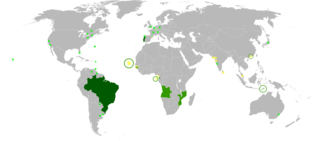
Olinda, is a historic city in the Brazilian state of Pernambuco, located on the country's northeastern Atlantic Ocean coast, in Greater Recife. It has a population of 389,494 people, covers 41.681 square kilometres (16.093 sq mi), and has a population of 9 inhabitants per square kilometer. It is noted as one of the best-preserved colonial cities in Brazil.
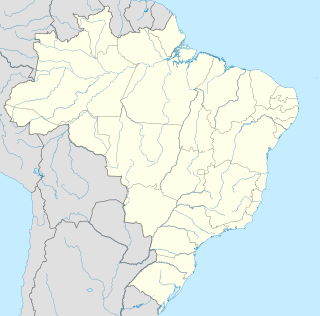
For people with the surname, see Salgueiro (surname).

Goiana is a city in Brazil in the northeast of the state of Pernambuco, about 65 km north of the city of Recife.

Igarassu is a city in the Brazilian state of Pernambuco. It is the second oldest city of the country and is situated on the north coast of the metropolitan region of Recife, approximately 32 kilometres (20 mi). It stands as one of the earliest European settlements in Brazil and is the site of the oldest church in the country, the Church of Saints Cosme and Damião, built in 1535. Igarassu is home to numerous colonial-period historic structures. The historic center of the city was designated a national monument by the National Institute of Historic and Artistic Heritage (IPHAN) in 1972.

Riachuelo is a municipality located in the Brazilian state of Sergipe. Its population was 10,116 (2016) and covers 78.31 km2 (30.24 sq mi). Riachuelo has a population density of 130 inhabitants per square kilometer. Riachuelo is located 23 km (14 mi) from the state capital of Sergipe, Aracaju. Riachuelo borders the municipalities of Laranjeiras, Divina Pastora, Santa Rosa de Lima, and Areia Branca, all within the state of Sergipe. The municipality is site of the Nossa Senhora da Penha Sugar Plantation and the Chapel of the Nossa Senhora da Penha Sugar Plantation. The chapel was listed as a historic structure by National Institute of Historic and Artistic Heritage (IPHAN) in 1943, but has fallen into an advanced state of neglect and decay and is considered abandoned.

The Roman Catholic Archdiocese of Olinda and Recife is a Latin Metropolitan archdiocese in southeast Brazil's Pernambuco state.

The Roman Catholic Archdiocese of Paraíba is a Latin Metropolitan archdiocese, atypically named after the state of Paraíba, in southeastern Brazil, rather than after its see.
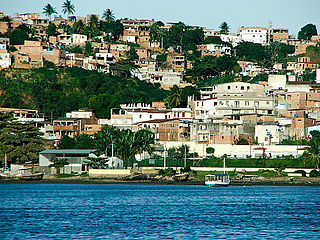
The Itapagipe Peninsula is a peninsula located in the city of Salvador, capital of the Brazilian state of Bahia. The peninsula comprises Administrative Region III, including the neighborhoods of Alagados, Boa Viagem beach, Bonfim, Monte Serrat, Ribeira, Uruguai, Mares, Roma, Caminho de Areia, Vila Ruy Barbosa, and Massaranduba, among others. Rua Fernandes Viêira and Avenida Afrânio Peixoto roughly form a boundary between the peninsula and the city of Salvador. The Church of Our Lady of Penha, one of the earliest structures, occupies the northern tip of the peninsula.
The following is a timeline of the history of the city of Recife, Pernambuco state, Brazil.

D. Manuel Álvares da Costa, also known as Manuel Álvares da Costa Claumann, was the 5th Bishop of the Diocese of Olinda, in Pernambuco, from 1706 to 1721, and 19th Bishop of the Diocese of Angra, from 1721 to 1733. He governed Pernambuco during the Mascate War.

The Parish Church of Our Lady of the Divine Shepherd is an 18th-century Roman Catholic church in the city of Divina Pastora, Sergipe, Brazil. The church venerates the Blessed Virgin Mary under her title Our Lady of the Divine Shepherd, also known as the Divina Pastora. The church is located approximately 39 kilometres (24 mi) from the state capital of Aracaju at the east of the city center of Divina Pastora. The date 1782 is inscribed on the façade of the church, indicating its probable date of completion. The parish church was listed as a historic structure by National Institute of Historic and Artistic Heritage (IPHAN) in 1943.

The Chapel of the Nossa Senhora da Penha Sugar Plantation is an 18th-century Roman Catholic church in the city of Riachuelo, Sergipe, Brazil. It is located approximately 39 kilometres (24 mi) from the state capital of Aracaju at the border of the municipalities of Riachuelo and Malhador. It was built as part of the Nossa Senhora da Penha Sugar Plantation and was listed as a historic structure by National Institute of Historic and Artistic Heritage (IPHAN) in 1943. It has fallen into an advanced state of neglect and decay and is considered abandoned.
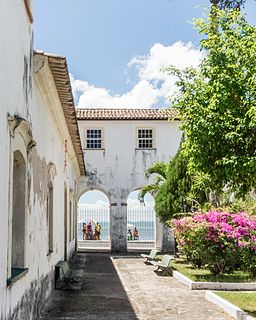
The Church of Our Lady of Penha is an 18th-century Roman Catholic church in Salvador, Bahia, Brazil. The church is located in the Ribeira neighborhood and constructed in 1742 as an extension of the Summer Palace of the Archbishop of the Roman Catholic Archdiocese of São Salvador da Bahia. The church sits at the end of the Itapagipe Peninsula and faces the Bay of All Saints. The Church of Our Lady of Penha was listed as a historic structure by the National Historic and Artistic Heritage Institute in 1941.

The Basilica and Convent of Nossa Senhora do Carmo Also Basilica of Recife It is a catholic architectural complex, belonging to the Our Lady of Mount Carmel, that is in Recife, Pernambuco State, Brazil.
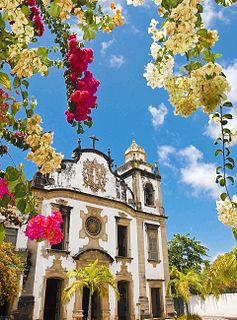
The Basilica and Monastery of St. Benedict Also Basilica of the Monastery of St. Benedict Is an important Catholic architectural complex built in Baroque style located in Olinda, Pernambuco, Brazil, which together with much of the historic center of the city, is a UNESCO World Heritage Site.

The Basilica of the Immaculate Conception, or the Basilica of the Conception, is a church in Salvador, Bahia, Brazil. It is affiliated with the Catholic Church and was built in 1623, making it one of the oldest parishes in the Roman Catholic Archdiocese of São Salvador da Bahia. It was the first church built by the first governor-general of Brazil, Tomé de Sousa. The current construction, in the Baroque style, was made with a model brought from Portugal. Its elevation to the status of basilica took place in 1946. Pope Pius XII declared Our Lady of Conception the sole patron of the State of Bahia.

The Church of Our Lady of the Conception of the Military is an 18th-century Roman Catholic church in Recife, Pernambuco, Brazil. It is located on Rua Nova in the historic center of Recife and is under the administration of the Roman Catholic Archdiocese of Olinda e Recife. The church was listed as a historic structure by the National Historic and Artistic Heritage Institute in 1941.

The Church of the Third Order of Our Lady of the Rosary of the Black People (Portuguese: Igreja da Ordem Terceira de Nossa Senhora do Rosário dos Pretos is an 18th-century Roman Catholic church in Salvador, Bahia, Brazil. The church was listed as a historic structure by National Institute of Historic and Artistic Heritage in 1938 and is part of the Historic Center of Salvador UNESCO World Heritage Site.

